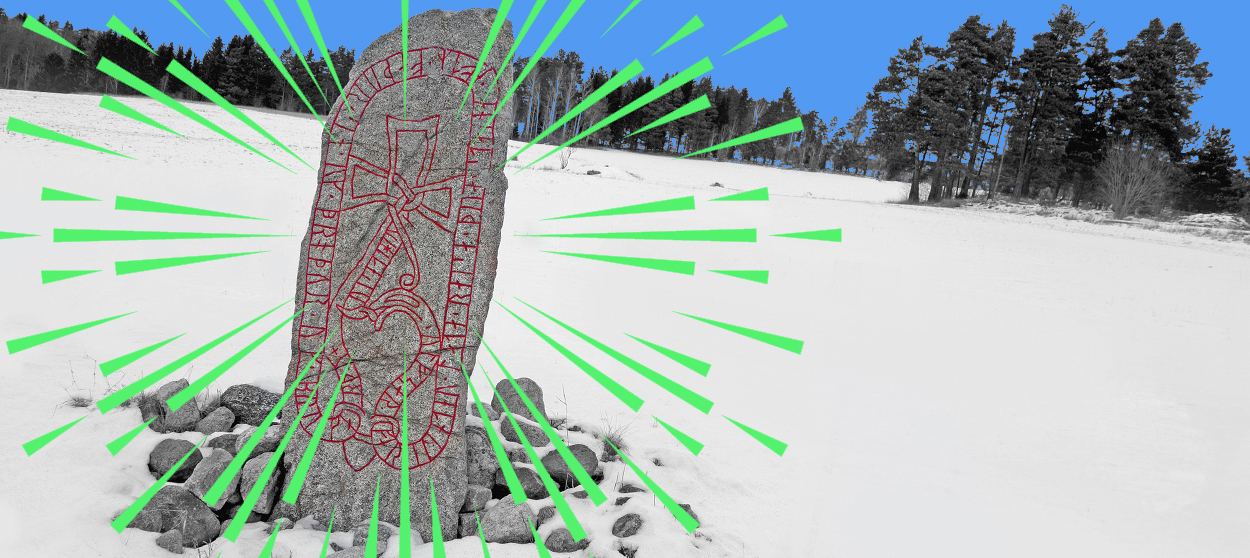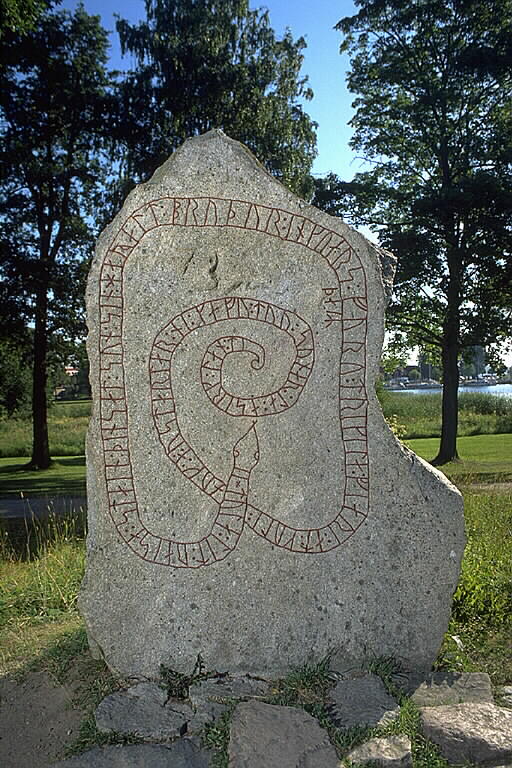Viking runestones were the original tweets
What ancient carvings tell us about modern social media

In the remote Swedish countryside, a 1,000-year-old stone slab stands raised by the side of a road. Chiseled onto it, a message has been carved in runes — symbols that served as letters in the ancient Germanic alphabet. The runes tell onlookers that a man named Alrik commissioned and raised this stone slab in commemoration of his father, Spjut, a Viking famous for destroying and laying siege to fortifications in the west. Alrik basks in the glory of Spjut's accomplishments: "Alrik raised the stone, son of Sigrid, after his father Spjut, he in the west had been, castle he had broken and conquered. The arts of the siege, he knew them all."

Thousands of Viking Age runestones like this one dot the Swedish landscape, providing direct glimpses into the lives of the Vikings. The messages are short, self-expressive, and, for us onlookers, very out-of-context. More often than not, they contain the unsolicited opinions of the person who commissioned the stone. In many ways, these ancient dispatches are similar to another, more modern style of communication: tweets.
A tweet, of course, is a message of no more than 280 characters that can be posted, shared, or liked on the social media platform Twitter. Twitter co-founder Jack Dorsey sent the first tweet in 2006. Since then, Twitter has grown into a platform with more than 200 million users. An estimated 22 percent of all Americans use Twitter. The allure of Twitter is the challenge of the limited number of characters and the opportunity to share opinions and information quickly with a large number of people.
The Week
Escape your echo chamber. Get the facts behind the news, plus analysis from multiple perspectives.

Sign up for The Week's Free Newsletters
From our morning news briefing to a weekly Good News Newsletter, get the best of The Week delivered directly to your inbox.
From our morning news briefing to a weekly Good News Newsletter, get the best of The Week delivered directly to your inbox.
Runestones became fashionable after Danish king Harold Bluetooth raised the Jelling Stone, dated to sometime between 960 and 985. Like tweets, the purpose of a runestone was to make a public statement. They were commonly placed where people could see them alongside roads, waterways, by property boundaries, or on hilltops. They are statements of power, wealth, lineage, and faith. They tell stories of love, loss, family, death, and mourning. They commemorate people who have died, but they are not gravestones. The individuals mentioned as deceased on a runestone lay buried in faraway places, such as Central Asia, the Middle East, and the British Isles.
The Jelling stone | (Courtesy Wikipedia)
Similar to the tweet, the message on a runestone is brief, mainly because it has to be. The weight of the stone limits its size, and in combination with the effort and skill required to make the runes, the message becomes truncated. Therefore, to understand the meaning of the message you need to be familiar with the event that the runestone is referring to, similar to when we encounter a subtweet.
Just as in the case of subtweets, searching for information elsewhere can provide the missing context. A woman named Estrid raised a stone in commemoration of her husband Östen, who died in the Byzantine Empire. According to Anders Winroth, professor of medieval history at Yale, Estrid and Östen have been identified in a visitors' ledger at a monastery in Switzerland on their way to the Holy Land. It would seem then that Estrid and Östen went on a pilgrimage from Sweden to the Middle East, and Estrid returned home alone.
A free daily email with the biggest news stories of the day – and the best features from TheWeek.com
Tweets and runestones also have in common that they make unilateral announcements of personal opinions and beliefs. Runestones were mostly raised by Christians to publicly declare their faith in opposition to the Pagans who surrounded them. The message on the runestone that Ulv and Ragnar raised in commemoration of their father Fare is brief and to the point: Fare was a Christian man with strong faith in God.
Social media is often described as a platform for self-aggrandizement and narcissism. What is more, this type of behavior tends to be ascribed to millennials and Gen Z, as if they invented it. A runestone raised by a man named Jarlabanke makes evident that the Vikings were well ahead of us. Instead of raising a runestone in commemoration of someone else, Jarlabanke raised a runestone for himself while he was still alive. On the stone, he claims ownership over all the surrounding lands and takes credit for creating the local assembly: "Jarlabanke let raise this stone after himself, while he was still alive, and he created this ... location, and he alone owned all of this hundred."
In the few years that social media has been around, our public display of grief and mourning has changed. On Twitter, hashtags such as #RIP and #OTD are used to bring us together when confronted with the passing of some famous figures. Runestones, too, were used for public mourning. The farmer Holmgöt raised a stone for his wife Odendisa. Their farm Hassmyra will never have a custodian as good as her, he proclaims for the world to read. More than 25 runestones speak of the loss of the sons, brothers, and husbands who went on a Viking expedition that ended in disaster in present-day Kazakhstan.

The runestones and the Vikings who made them show us that they way we express ourselves on social media is not a new phenomenon; only the medium has changed. Runestones and tweets demonstrate our need to communicate where the intention is not to receive a reply, but to be heard on our own terms and to leave a mark.
The difference between how the Vikings did it and how we do it, is the reach and the volume of our messages. Platforms such as Twitter enable us to post several times a day and be heard across the planet, while the commissioning of a runestone was a large investment rarely made more than once. But the messages that we send out into the world are the same: This is me, and this is my family. This is what I believe, this is what I have achieved, and this is how I mourn.
-
 Political cartoons for December 20
Political cartoons for December 20Cartoons Saturday’s political cartoons include drowning rats, the ACA, and more
-
 5 fairly vain cartoons about Vanity Fair’s interviews with Susie Wiles
5 fairly vain cartoons about Vanity Fair’s interviews with Susie WilesCartoon Artists take on demolition derby, alcoholic personality, and more
-
 Joanna Trollope: novelist who had a No. 1 bestseller with The Rector’s Wife
Joanna Trollope: novelist who had a No. 1 bestseller with The Rector’s WifeIn the Spotlight Trollope found fame with intelligent novels about the dramas and dilemmas of modern women